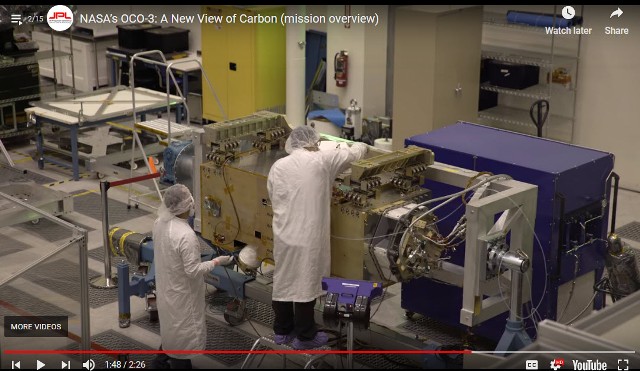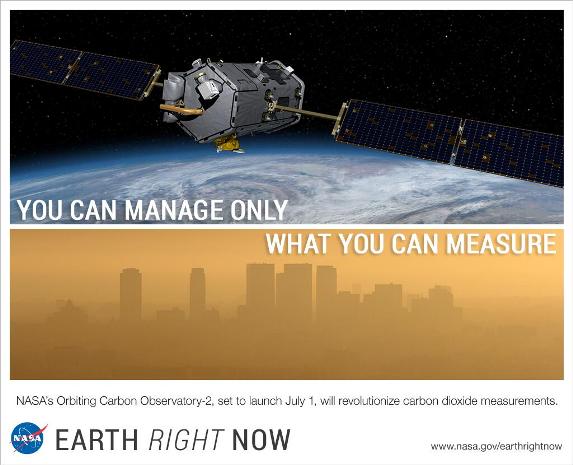File:OCO-3 video.jpg
OCO-3_video.jpg (640 × 371 pixels, file size: 76 KB, MIME type: image/jpeg)
OCO-3 arrives at International Space Station, May 6, 2019, installed on May 10
(Watch the OCO-3 MissionVideo) https://m.youtube.com/watch?v=7GMjU5pSufk&feature
Op-ed: The story behind the satellite that Trump wants dead
- The Orbiting Carbon Observatory's primary job is to see what's happening to the carbon dioxide levels in our atmosphere.
There were plenty of striking things about February 12th's budget news, given that it contained lots of draconian cuts that were simultaneously restored because Congress had boosted spending the week before. But perhaps the most striking among them was an item in the proposed budget for NASA: Trump wants to block the follow on to a highly successful NASA mission.
To truly appreciate just how awful this is, you have to understand the history of that satellite and what it means to the scientific community as a whole. So let's step back and take a look at why the Orbiting Carbon Observatory (or OCO) exists in the first place. It turns out it was built specifically to handle some outstanding questions of the sort that people in the administration say are important, and killing its successor would mean the existing mission never lives up to its full potential.
- * https://arstechnica.com/science/2018/02/op-ed-the-story-behind-the-satellite-that-trump-wants-dead/
Trump attempts to cut the OCO-2 and OCO-3 missions: US Congress restores them
The U.S. President attempted to kill the OCO-3 atmospheric CO2 measuring mission by budgeting out the earth science
The U.S. Congress says no to the president and yes the future of studying - measuring - monitoring the earth's atmosphere and climate
GreenPolicy360: The essential importance of providing a baseline of data with which to make informed decision about the condition and changes in earth's atmosphere have continued since the first NASA mission statements. The recent attempt by a national leader, who has denied the reality of climate change and global warming, to end the OCO program, the premier program of the U.S. science establishment to measure and monitory greenhouse gases was a serious security threat in and of itself. History will look back and judge this attempt to end the OCO-3 program. We, at GreenPolicy360, salute the members of Congress who carried on with the NASA led OCO mission. The science is a critical element in working toward national and global security, which must be a foremost priority. Time is of the essence.
NASA's Orbiting Carbon Observatory-3 (OCO-3) was installed on the International Space Station (ISS) on 10 May 2019. OCO-3 combines the flight spare spectrometer from the Orbiting Carbon Observatory-2 (OCO-2) mission, which has been in operation since 2014, with a new Pointing Mirror Assembly (PMA) that facilitates observations of non-nadir targets from the nadir-oriented ISS platform. The PMA is a new feature of OCO-3, which is being used to collect data in all science modes, including nadir (ND), sun-glint (GL), target (TG), and the new snapshot area mapping (SAM) mode.
OCO-3 was launched to the International Space Station (ISS) from Kennedy Space Center, Florida on 4 May 2019 at 06:48 UTC on a Space-X Falcon 9 rocket. The Dragon capsule docked with ISS on 6 May 2019 and the OCO-3 instrument was extracted from the Dragon trunk 3 days later (9 May 2019) and installed on the Japanese Experiment Module Exposed Facility (JEM-EF) on 10 May 2019. OCO-3 completed its 90 day In-Orbit Checkout (IOC) and began collecting science measurements on 6 August 2019 (orbit, or” solar day” number 1456).
OCO-3 uses the flight spare spectrometer from the OCO-2 mission, which has been taking data from a 705-km altitude, near-polar, sun-synchronous orbit since September 2014 (Crisp et al., 2017). Like the OCO-2 instrument, the OCO-3 spectrometer includes three spectral channels, centered on the molecular oxygen-A band (ABO2) at 0.765 μm and the two CO2 bands at 1.61 μm (WCO2) and 2.06 μm (SCO2).'
OCO-3 News Coverage Should Have Been of a Globally Important Event
OCO-3 arrives at the International Space Station to begin its earth science-space mission. There's little to find in Media coverage on its real-world importance whether on Google News, Bing Search, Yahoo, Duck Duck Go, pick your international news sources...
Yet, in fact and substance, the science of OCO-3 is critically important. Earth Science. Measuring CO2. JPL-Caltech/NASA, scientific inquiry at its best. Essential data and baseline information critical for informed policy and decision-making (yet President Donald Trump tried to kill the launch of OCO-3 and related US FY2018 missions to measure and monitor CO2).
A global security story... National security... Existential threats ...
OCO-3 Arrives at the International Space Station
(Interview at JPL courtesy of the LA Times)
OCO-3 was built at the Jet Propulsion Laboratory in La Cañada Flintridge for less than $100 million, using parts left over from its predecessor, OCO-2. Once the carbon observatory gets to the ISS, a robotic arm will mount it on the underside of the space station so it can keep a close eye on the carbon dioxide in Earth’s atmosphere.
That will help scientists answer questions about how and why levels of the greenhouse gas fluctuate over days, months and years.
“Our goal is to get really good data so we can make informed decisions about how to manage carbon and carbon emissions in the future,” said Annmarie Eldering, the mission’s project scientist at JPL.
Carbon dioxide makes up a tiny fraction of the molecules in our atmosphere — roughly 400 parts per million. But seemingly small changes in the amount of carbon dioxide in the atmosphere have an outsized effect on the planet’s temperature.
“Carbon is really effective at trapping heat,” Eldering said. “Even changing the ratio from 300 parts per million to 400 parts per million makes a big difference.”
OCO-3 is so sensitive that it can detect changes as small as 1 part per million. So if CO2 levels go from 406 ppm one day to 407 ppm the next, the observatory will record the increase.
Eldering, who also worked on OCO-2, spoke to The Times about the difference between the two instruments, the new information she hopes to learn from OCO-3, and how she and her team managed to keep their cool when their project seemed headed for the chopping block.
Q: What are the main science questions you hope OCO-3 will answer?
The big science question is about the movement of carbon dioxide between plants and the atmosphere.
If you look at the ground-based data, it almost looks like the planet is breathing. Plants in the northern hemisphere take up carbon dioxide as they grow in the spring and summer, reducing the amount of CO2 in the atmosphere by a few parts per million. In the fall, the leaves drop and carbon is released back into the air.
But every year is different. There are changes in the forests in Canada. El Niño years affect the carbon cycle.
What we want to do is find drivers of the plant uptake of carbon and use that to better predict what will happen in the future. If we have a warmer, drier climate, will plants keep taking up as much carbon?
Q: Why is it helpful to look at Earth’s carbon cycle from space?
We have Earth-based data, but having a satellite observatory lets you see things in a bigger context. That includes data over the oceans that the ground-based measurements generally don’t see.
Q: Can you give me an example of something you learned from data collected by OCO-2?
In 2015 and 2016, there was a global weather pattern called an El Niño that had a big impact on the carbon cycle in South America, South Africa and Indonesia, but in different ways.
South America had drought, so the plants there were not as active and did not remove as much carbon dioxide as they usually do. In the tropical part of Africa it was super hot, so the plant material was decomposing fast and releasing carbon dioxide. And Indonesia was on fire — that put a lot of carbon back in the air.
Before we would have said, “El Niño is affecting the tropics” and just leave it at that. Now we can tease that apart in more detail, and that is really exciting as a scientist.
Q: How is OCO-3 different than OCO-2?
The main purpose of OCO-3 is to make sure we have a continuous record of carbon dioxide levels in the atmosphere, but we are adding some new capabilities. One of those is to take a snapshot of carbon levels over an area of 50 miles by 50 miles. This will feed a bunch of science investigations of emission hot spots, like cities or volcanoes.
We can also look at how plant activity changes over the course of a day, which is something OCO-2 could not do.
Q: How does OCO-3 work?
OCO-3 is a spectrometer that looks at Earth’s surface in three wavelengths: two for carbon dioxide, and one for the type of light your eyes see. Every molecule has a unique way that it absorbs light, almost like a fingerprint, and that’s what we exploit in our instrument.
If the CO2 levels are 405 ppm, we will see a certain amount of light change in the CO2 band. If it is 406, we’ll see just a bit more.
Q: President Trump tried to cancel this mission twice. How stressful was that for you and your team?
I’ve been over at JPL for 20 years now, and this is not the first mission I’ve worked on that has had funding ups and downs. We are fortunate that we have three branches of government, and that Congress is very active and has kept the importance of this work in mind as they created the budget.
My strategy for getting my work done is just to put on blinders and get the work done.
More Than a Carbon Copy: OCO-3 on the Space Station -- https://www.jpl.nasa.gov/news/news.php?feature=7364
OCO-3 Ready to Extend NASA's Study of Carbon -- https://www.jpl.nasa.gov/news/news.php?feature=7389
- • https://www.greenpolicy360.net/w/OCO-2
- • https://www.greenpolicy360.net/w/Earth_Science_Research_from_Space
- • https://www.greenpolicy360.net/w/Category:Global_Security
- • https://www.greenpolicy360.net/w/New_Definitions_of_National_Security
○
File history
Click on a date/time to view the file as it appeared at that time.
| Date/Time | Thumbnail | Dimensions | User | Comment | |
|---|---|---|---|---|---|
| current | 21:29, 10 May 2019 |  | 640 × 371 (76 KB) | Siterunner (talk | contribs) |
You cannot overwrite this file.
File usage
- Atmospheric Science
- Anthropocene
- Atmosphere
- Ecology Studies
- EOS eco Operating System
- Sustainability
- Sustainability Policies
- Biosphere
- Digital Citizen
- Earth360
- Earth Observations
- Earth Science
- Eco-nomics
- Education
- Environmental Full-cost Accounting
- Environmental Security
- Environmental Security, National Security
- Global Security
- Global Warming
- NASA
- National Security
- New Definitions of National Security
- New Space
- Planet Citizen
- Planet Scientist
- Planet Citizens, Planet Scientists
- Planet API
- Strategic Demands
- ThinBlueLayer
- Whole Earth
- Climate Change
- Climate Policy
- Arctic
- Cryosphere
- Geophysics and Geochemistry
- Geophysics
- Hydrology
- Natural Resources
- Ocean Science
- Planetary Science
- Space Science and Space Physics



